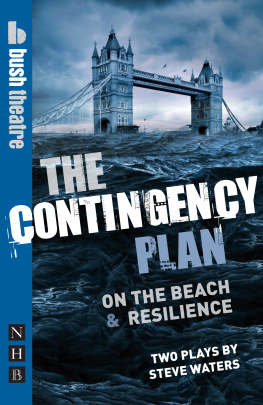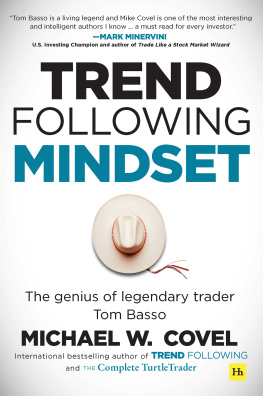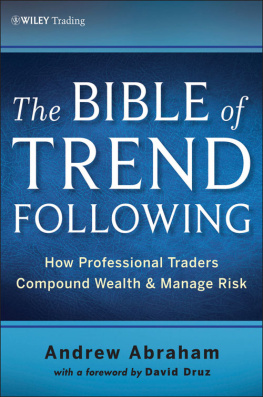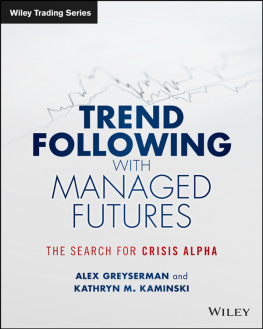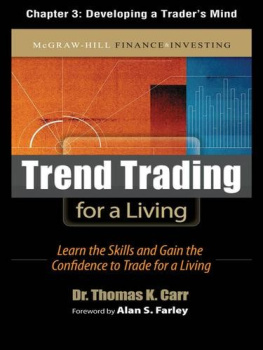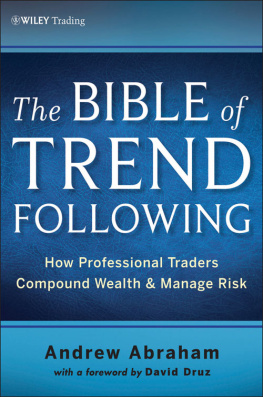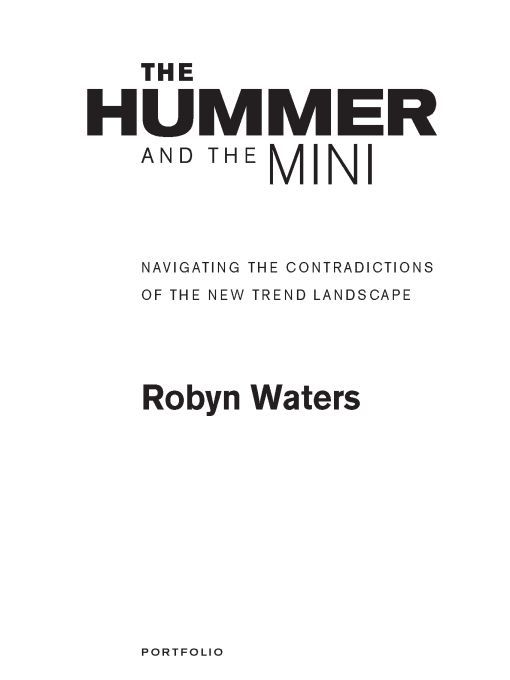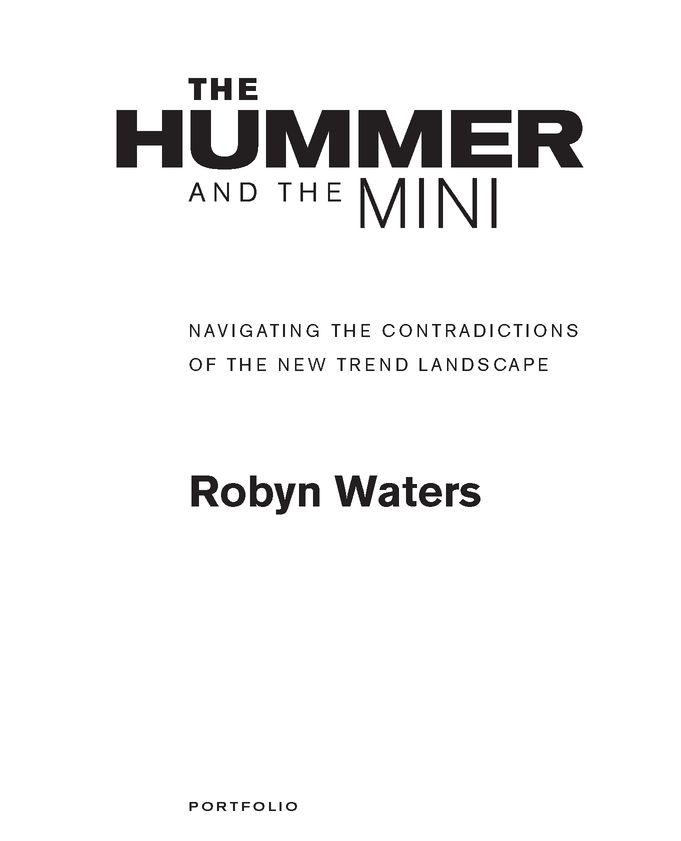Table of Contents
To Gary: A designer who brings beauty to the ordinary. A cowboy as at home on the range as he is at the opera. A husband who knows how to hold tight while letting go.
Serious things cannot be understood without laughable things, nor opposites at all without opposites.
Plato, 428-348 B.C.
INTRODUCTION
MY FIRST BOOK,THE TRENDMASTERS GUIDE: GET A JUMP
on What Your Customer Wants Next, is a small, witty A-to-Z handbook designed to simplify and demystify the art of trend tracking. It outlines my unique philosophy on tracking and translating trends into sales and profit. Its about the how of Trend.
In the last chapter, Z is for Zen, I introduce the reader to my perspective and insights on trend/countertrend. I quote Lao-tzu, ancient Chinese philosopher, who captured the essence of what fascinates me most about the art of trend tracking: When opposites supplement each other, everything is harmonious. I wrote that for every yin there is a yang. For every trend there is a countertrend. I encouraged the reader, in true Zen fashion, to embrace opposites. Celebrate duality. Embrace polarity.
This book picks up where The Trendmasters Guide leaves off. The Hummer and the Mini explores the what of Trend. Its an overview of high-level macro trends happening in the world today. In essence, its a study of paradoxes, concepts that at first glance seem absurd or contradictory, but in reality are absolute truths. Dr. Marty Grothe, in his book Oxymoronica, points out that paradox is a particularly powerful device to ensnare truth because it concisely illuminates the contradictions that are at the very heart of our lives.
Perhaps thats what fascinates me most about paradox; the way it illuminates the truth. A paradox captures the essence of whats going on out there in the world while at the same time cautioning that things arent always as they appear at first glance. When explored with an open mind, paradoxes will help you read between the lines and reframe your perspective.
Paradoxes are powerful tools that can help you discover the opposing realities of the customer and the contradictory aspects of the marketplace. Too many businesses try to make it a black-and-white proposition. Either/or. I believe that within the paradox lies an opportunity to get out of the black-and-white box and step into a world of colorful possibilities.
My years at Target taught me a thing or two about paradox. When I came to Target in 1992, it was a small regional discounter with a funny bulls-eye logo trying to survive in a marketplace dominated by Wal-Mart and cluttered with many other small regional discounters. Target realized that in order to survive, let alone compete in that retail scene, it would have to differentiate or die. The discounters that didnt figure that out, did in fact die off... Venture, Zayres, to name two. And Kmart is still struggling to keep its head above water.
Targets formula was a simple one, consisting of three parts. First, the company was determined to capitalize on its department store heritage and be the first discounter to be trend right. Rather than carrying last years best sellers the following year at a reduced price, our goal was to have the same products on our floors at the same time that Gap, Crate & Barrel, and Banana Republic were stocking, only at better prices.
The second part of the formula was to be guest focused. We called our customers guests, in the tradition of Disney. We wanted to know not just the age, income level, and zip codes of our customers; we wanted to know what their lives were like, how they lived, what they felt, and what they cared about.
The third part of the formula was the secret sauce. The company made a huge commitment to design. Design would be the tool used to translate the trends into great products and experiences that made sense for our guests lives. Ultimately, design was the competitive weapon that brought beauty not just to the product, but to the bottom line. It brought credibility to the brand promise Expect More. Pay Less. Its also what helped turn Target into Tarzhay.
Trend right. Guest focused. Design driven. The three key elements of the strategy that ultimately turned Target into the upscale discounter. Now theres a paradox.
The trends outlined in this book are all paradoxes. They highlight the contradictory nature of these trends, and I hope they will help you reevaluate your point of view. The insights I share in this book will take you deep into the hearts and minds of your customer to help you determine not just whats next, but whats important.
You will find no big pronouncements here. No predictions. No prescriptions. And no pat answers. Charles Handy, a pre-eminent British management guru and one of my business heroes said: Paradoxes are like the weather; something to be lived with, not solved. Instead of answers, I hope to help you discover the possibilities. This book will help you explore the apparent contradictions manifesting themselves out there on the treacherous trend landscape. I hope it ultimately provides you a new way of looking at your world.
As I travel the country sharing my philosophy on the art of trend, Ive been amazed at how open people really are to looking at things differently. Corporations have finally realized that they cant cut their way to greatness anymore. Instead, its time to put something back into the product. That takes real innovation, and innovation usually requires doing things in a new way.
Many of the stories that I profile in the book are examples of businesses that at one time might have thought inside the box when the marketplace was a simpler, more sane place. Today, however, companies such as Starbucks, Whole Foods, Mini Cooper, M&Ms, Costco, Jones Soda, DaVinci Slate, and MetroNaps have all realized that there is no box. Its no longer even a matter of thinking outside the box. Companies that have embraced change and accepted the idea of the contradictory consumer have found delightful ways to reframe their business propositions. By paying attention to both ends of the trend spectrum, theyve been able to develop a unique proposition that helps drive their success.
Businesses today need to embrace change and live with the paradoxes. They have to admit to themselves that the same old, same old just wont do. I hope this book provides a little guidance, a polite nudge, and some interesting insights to help you not just think outside the box, but to throw the box away altogether.
We live in a world filled with paradox. Its a fact of life. Margaret Mead said, We should always remember that we are absolutely unique, just like everyone else. If you can embrace that thought, youll have no problem embracing the paradoxes contained within.
CHAPTER 1
TREND/COUNTERTREND
WHEN I BEGAN MY CAREER IN THE LATE 1970S, THE TREND- spotting business was pretty black and white. A trend was defined as something that everyone wanted at the same time. Fashion magazines and business publications alike regularly proclaimed what was in and what was out. Trends were distilled down to easy-to-decipher thumbs up or thumbs down messaging.
Back then, if you kept your antennae up, your radar out, and connected the dots, you could pretty much determine what the next big trend was going to be. If you were smart enough to do something about it fairly quickly, you could make a lot of money and ride that trend all the way to the bank.






